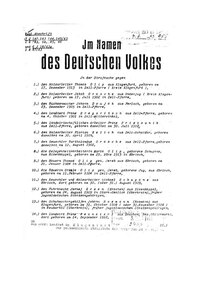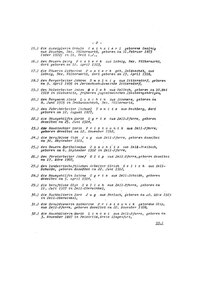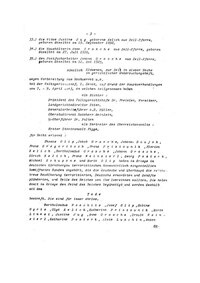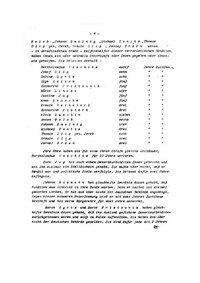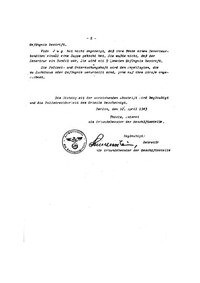Thomas Olip
Thomas Olip (born on December 17, 1913 in Sele-Fara ; died on April 29, 1943 in Vienna ) was a Slovenian resistance fighter against National Socialism in Carinthia . He was executed with the guillotine by the Nazi judiciary .
Life
Thomas Olip was born out of wedlock in Zell-Pfarre near "Ogradnik" in Southern Carinthia in the Slovenian-speaking area. Olip was raised Catholic by his mother Maria, attended elementary school in Zell-Pfarre and volunteered in the Austrian Infantry Regiment No. 7 in Klagenfurt on September 1, 1937 , from which he was released on April 30, 1938 after the "Anschluss" . He was a member of the Fatherland Front , the Forest Workers' Union of Austria and the Catholic-Slovenian cultural association in Zell. On September 15, 1938 Olip was drafted into the mountain infantry regiment 139 in Klagenfurt, but was already on 19 September AWOL and deserted in uniform to Yugoslavia. In Kranj ( Krainburg ), Thomas was questioned six times by Yugoslav officers about the military strength of the Klagenfurt garrison. After the end of the war with Yugoslavia , he returned to Carinthia on April 20, 1941.
Slovenian resistance
At first he lived in the forest with Jakob Oraže and Josef Malle and was provided with food by Franc Pristovnik from his father's helm. He then went to Ebriach near the property of his uncle Thomas Olip, where he persuaded his cousin Maria Olip to provide him with food. At the end of 1941 Pristovnik put him in touch with the brothers Johann, Peter and Valentin Olip and the deserted Johann Gruden . Thomas Olip and Jakob Orasche spent the winter of 1941/42 in a farm building on the Pristovnik farm. He belonged to the so-called “green cadres”, Slovenian resistance fighters in southern Carinthia, who did not want to join the communist Osvobodilna Fronta in Yugoslavia.
In the spring of 1942, Olip and Jakob Orasche built their first bunker near Pristovnik's farm on Setitsche Hill; Pristovnik gave them the tools to do it. In June 1942 they built a second bunker in a ravine above the Hlipoutschniksäge, in which they temporarily lived.
In July 1942, Thomas Olip received from Ivan Zupanc , who came from the partisan camp at Strachwitz, in the bunker above the Hlipoutschniksäge von Zell, the order from the Slovenian partisan leader Crtov (Tschertou) to come to his camp. Thomas Olip went there with Max Kelich and the next day received the order to fetch the four other bunker residents as well. After a long discussion, however, the two decided to stay in the bunker independently as a “green cadre”. Thomas Olip noted in the diary that he felt "very happy" while doing it.
The cooperation with Zupanc continued; he came about 14 days later to get weapons. Thomas went to Ferlach to see the gunsmith Johann Doujak, whom he had met while poaching on Javornik and from whom he had taken a poacher's rifle and shortly afterwards he was able to take over a delivery of weapons with a rifle and ammunition on the 1600 m high Matzenberg with Max Kelich and Jakob Orasche, of which the group around Zupanc received a part.
On August 12, 1942, Zupanc came back to the bunker to fetch people. But only Thomas Olip went with Zupanc to Ebriach, where Peter Blazic from Slovenia and other partisans were. Zupanc said that the hunter Urbas in Ebriach had to be killed. In 1935 he shot two Slovenes from Carniola on the Meleschniksattel near Ebriach who had captured weapons in Ferlach. Olip showed the people of Zupanc the way to Urbas, who was shot while trying to escape. On August 14, 1942, two days after witnessing the murder of the hunter Urbas in Ebriach, Thomas Olip was ordered to take the partisans to the Kalischnikhof on the Schaidasattel. According to his diary, Olip offered the partisan leader Crtov to cross the old border and bring in more deserters. In the minutes of the People's Court it says: “Thomas Olip stood on the post and felt like he was 'very happy' in a diary that he kept of his experiences! Then Thomas Olip showed them the way to Urbas and stopped near his house on the edge of the forest. He saw how the others shot at Urbas when he stepped out of his house, how he fled into his house, then handed over his weapons upon urgent request, came out of the house on further 'orders' and tried to escape but was shot down. “On October 4, 1942, the communist political commissar Stane Mrhar reported to the command of the Slovenian Liberation Front (OF) that only“ Tomo ”(= Thomas Olip) and Max Kelich,“ Jaka ”(= Jakob Orasche ) is disabled. This shows that Thomas Olip was known to the partisans and they wished that he would join them. However, it did not join.
Discovery and Arrest
After the partisan group in Eisenkappel was broken up, the Gestapo turned to the Zellans after intercepting a letter from Zupanc and arresting his sister Maria Olip . The seriously injured prisoner Peter Blazic took the Gestapo to the Olips bunker in Zell. On December 1, 1942, Olip was captured in the bunker in Zell together with Jakob Orasche. His diary, which contained detailed information about people who had supported the partisans, was the undoing of many resistance fighters. During the trial against the Zellaner, Franc Pristovnik was accused of having persuaded Thomas Olip to “go to the bandits in Upper Carniola”. Florian Kelich was accused of having “served Thomas Olip several times as a contact point for months. He allowed him to sleep in the hay with him and fed him now and then. ”According to Olip's diary, there were more than 30 meetings with Bartholomäus / Jernej Orasche. Johann Orasche was accused of having met Thomas Olip, "who he also knew had deserted abroad." Olip's diary shows that Kelich "not only talked once ..., but that he spoke several times." has gone to him “and this entertained him.
Olip's diary was carefully evaluated by the Gestapo; The Slovenian lawyer Anton Jelen was questioned in Klagenfurt prison about his contacts with the Olip brothers in Ljubljana. From January 12, 1943, further arrests were made; on April 12, 1943, the verdict of the People's Court under Roland Freisler in Klagenfurt took place. The 13 Zellaner sentenced to death were beheaded on April 29, 1943 at the Vienna Regional Court. Olip's body was exhumed in 1949 with the rest of the executed and buried in Zell-Pfarre. Thomas Olip's diary is one of the most important literary testimonies to the resistance against National Socialism among the Slovenes and in Austria. In the Moscow Declaration , the rebuilding of Austria after the overthrow of National Socialism was made dependent on the fact that there had to be armed resistance against the Nazi regime in Austria as well. After 1945, the Austrian government invoked this resistance from the Carinthian Slovenes; however, the establishment of the bilingual place-name signs has not yet been completed.
In 2010, Peter Handke created a literary monument for the green cadres of Zell Pfarre / Sele fara in his work Immer noch Sturm .
literature
- Franc Kattnig (Ed.): All Slovenes. Klagenfurt, 1976
- Karel Prusnik-Gasper: Chamois on the avalanche. The Carinthian partisan struggle. Klagenfurt, 3rd edition 1984, ISBN 3-85129-562-5
- Search for clues. Narrated story of the Carinthian Slovenes. Vienna, 1990
- August Walzl: Against National Socialism. Klagenfurt, 1994
- Anton Jelen: On the trail of hope. Odyssey of a Carinthian Slovenian (1938-1945). Klagenfurt, 2007
- Wilhelm Baum , Thomas Olip, in: The book of names. The victims of National Socialism in Carinthia. Kitab, Klagenfurt, 2010, pp. 646–649
- Thomas Olip (Author), Wilhelm Baum (Ed.): Like a bird locked in a cage. Kitab, Klagenfurt 2010, ISBN 978-3-902585-56-1 .
- Wilhelm Baum: The Freisler Trials in Carinthia. Klagenfurt 2011, ISBN 978-3-902585-77-6
- Vinzenz Jobst (Ed.): Punished with death - forever dishonorable? Kitab, Klagenfurt 2013. ISBN 978-3-902878-24-3 .
Individual evidence
- ↑ Death sentence (PDF; 432 kB)
- ↑ Erwin Hirtenfelder, felt like I was in a cage , Kleine Zeitung , August 24, 2010
| personal data | |
|---|---|
| SURNAME | Olip, Thomas |
| BRIEF DESCRIPTION | Austrian resistance fighter |
| DATE OF BIRTH | December 17, 1913 |
| PLACE OF BIRTH | Zell parish |
| DATE OF DEATH | April 29, 1943 |
| Place of death | Vienna |
